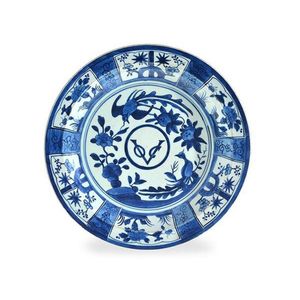Arita V.O.C. Plate with Phoenix and Flowers
You must be a subscriber, and be logged in to view price and dealer details.
Subscribe Now to view actual auction price for this item
When you subscribe, you have the option of setting the currency in which to display prices to $Au, $US, $NZ or Stg.
- East India Company - The British East India Company was a British trading company that was active from 1600 to 1858. It was one of the leading commercial enterprises of its time and played a key role in the development of British trade and commerce with India, China, and Southeast Asia.
The British East India Company was granted a monopoly on trade with the East Indies by the English government, and it quickly established a network of trading posts and settlements throughout India and Southeast Asia. The company was involved in numerous wars and conflicts in India and Southeast Asia, and it gradually gained political influence over large parts of the region.In addition to its commercial activities, the British East India Company was also involved in the spread of British culture and influence in the regions it traded with. The company played a significant role in the introduction of British goods, ideas, and institutions in India and Southeast Asia, and it was instrumental in the establishment of the British Empire in India.The British East India Company was dissolved in 1858, following the Indian Rebellion of 1857.
The Dutch East India Company, also known as the Vereenigde Oost-Indische Compagnie (VOC), was a Dutch trading company that was active from 1602 to 1798. It was one of the first multinational corporations in the world and one of the largest commercial enterprises in history.
The Dutch East India Company was established with the goal of establishing a trade monopoly in the spice trade with the East Indies. The company was granted a 21-year monopoly on the Dutch spice trade, and it quickly became one of the most successful and powerful trading companies in the world.
Over the course of the 17th and 18th centuries, the Dutch East India Company expanded its reach and influence throughout Southeast Asia, the Indian subcontinent, and the Far East. The company established a network of trading posts and colonies, and it played a major role in the commercial and political development of many regions in Asia.
Despite its commercial success, the Dutch East India Company was also notorious for its ruthless treatment of local populations and its exploitation of resources. The company was involved in numerous conflicts and wars throughout its history, and it was accused of using slave labor and engaging in acts of piracy.
The Dutch East India Company was dissolved in 1798. - Circa - A Latin term meaning 'about', often used in the antique trade to give an approximate date for the piece, usually considered to be five years on either side of the circa year. Thus, circa 1900 means the piece was made about 1900, probably between 1895 and 1905. The expression is sometimes abbreviated to c.1900.
- Ming Dynasty - The Ming Dynasty was a ruling dynasty of China from 1368 to 1644. It succeeded the Yuan Dynasty and preceded the Qing Dynasty. The Ming Dynasty was established by Zhu Yuanzhang, a former Buddhist monk who became a rebel leader and eventually overthrew the Mongol Yuan Dynasty. During the Ming Dynasty, China experienced a period of relative stability and prosperity. The government was centralized and bureaucratic, with the emperor at the top of the hierarchy. The Ming Dynasty is known for its cultural achievements, including the development of porcelain, the invention of movable type printing, and the construction of the Great Wall of China.
This item has been included into following indexes:
- Chinese antiquities by dynasty - Ming Dynasty 1,256
-
Japanese ceramics, factories and cities
- Arita 130
- Kraak style 13
- Japanese ceramics, styles and decoration - blue and white 189
-
Satsuma (Japan), item type
- dishes 227
- plates, platters and chargers 575
Visually similar items

A Japanese Arita ware monogrammed charger, possibly late Edo period (mid 19th century), in typical underglaze blue and white, with a central Dutch East India Company monogram encircled by a floral, fruit and bird motif, the cavetto and rim with panels of d

A large Oriental 'Voc' Dutch East India Company charger, the replica charger decorated in the Chinese kraak style in blue on a celadon grey ground, the wide border with alternate panels of flowers and fungus and centred with the interlocking Voc logo. Heig

An old armorial Chinese export ware blue and white charger, blue and white encircling leaf scroll and other bands, the fielded shield form cartouche with diagonal stripes, fine dark brown glazed rim, underglaze blue mark to the reverse within twin circles.

A large Japanese Arita blue and white dish, 19th century, decorated in Kraak style with long tailed birds amongst peony, surrounded by panels with other flowers and auspicious symbols, diameter 31 cm
